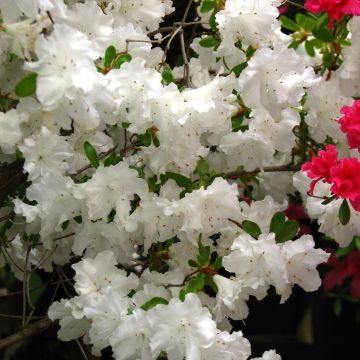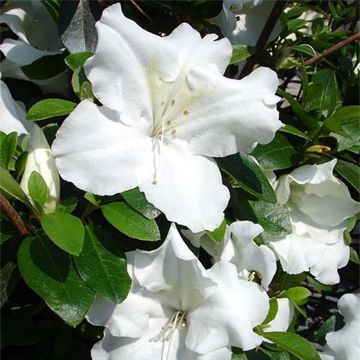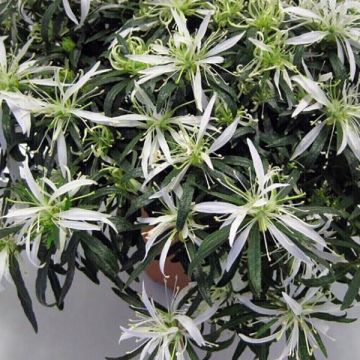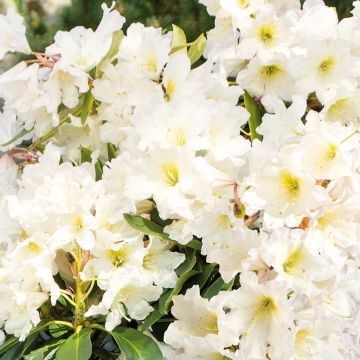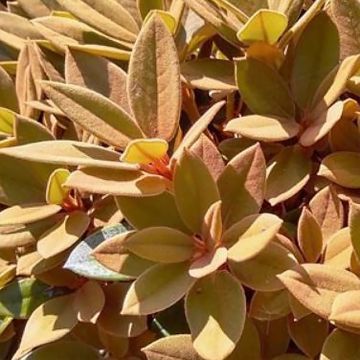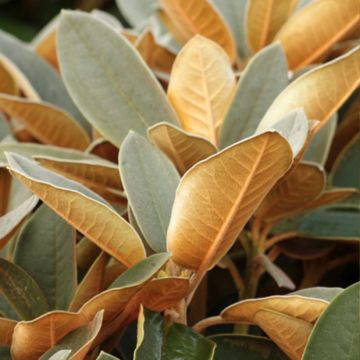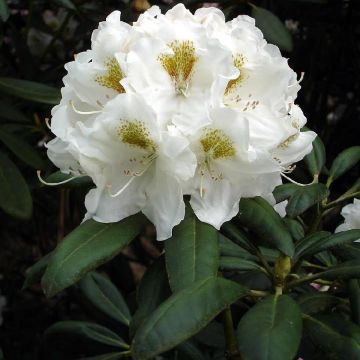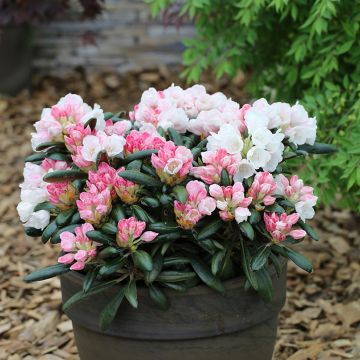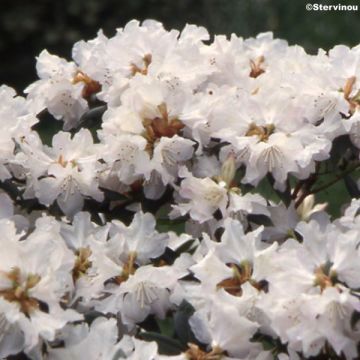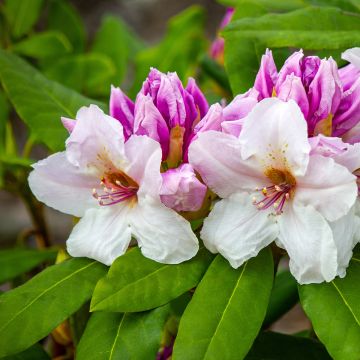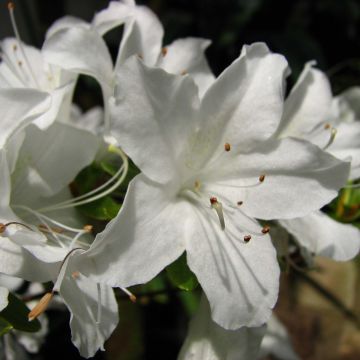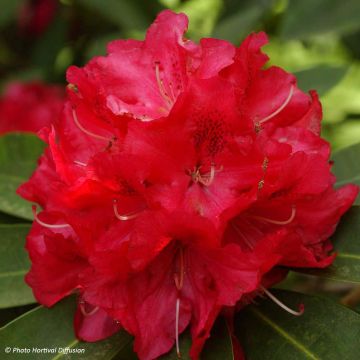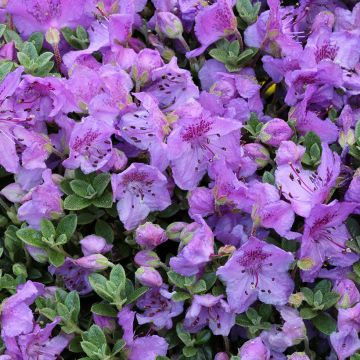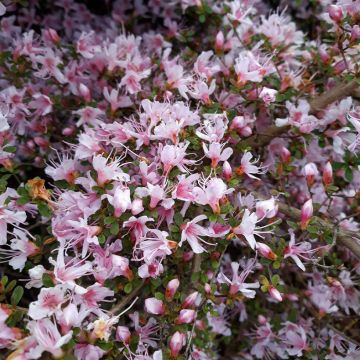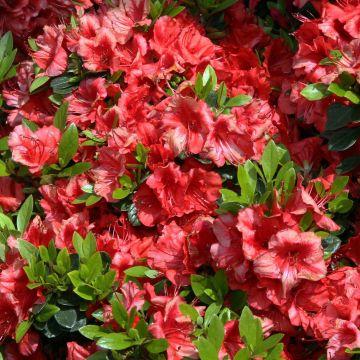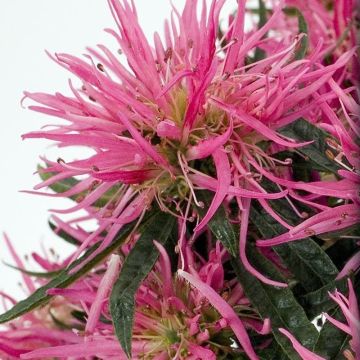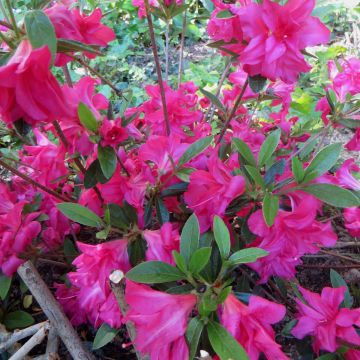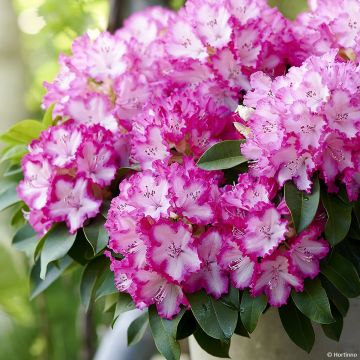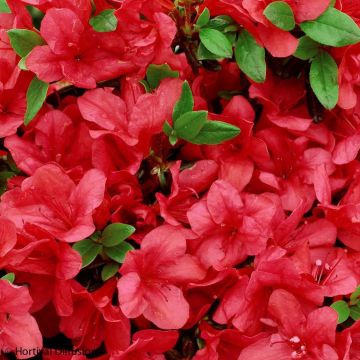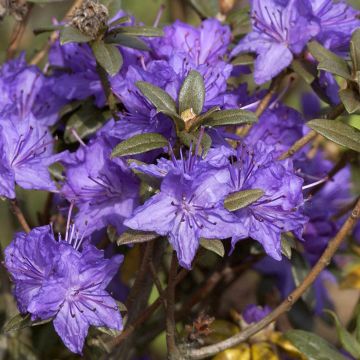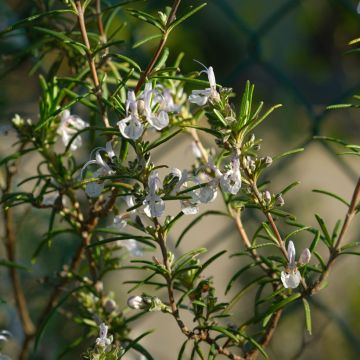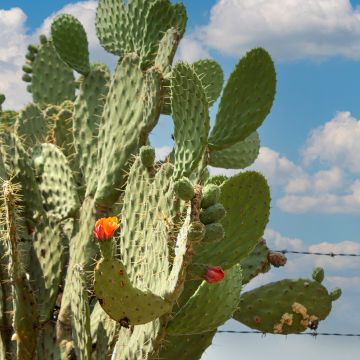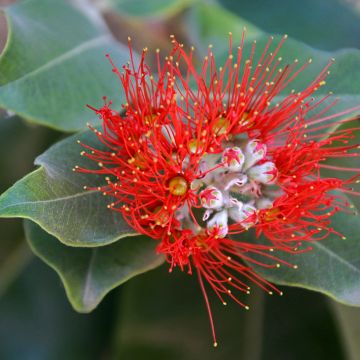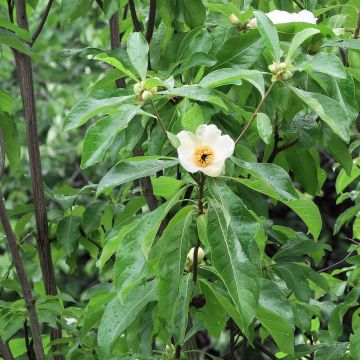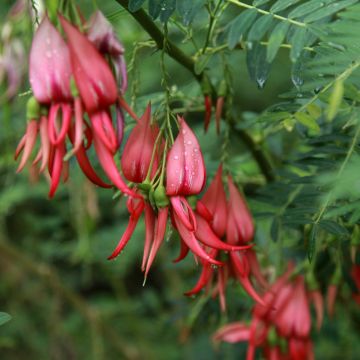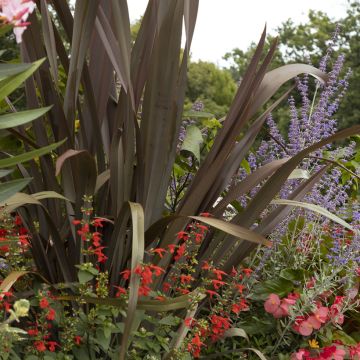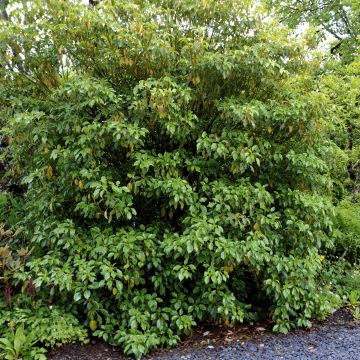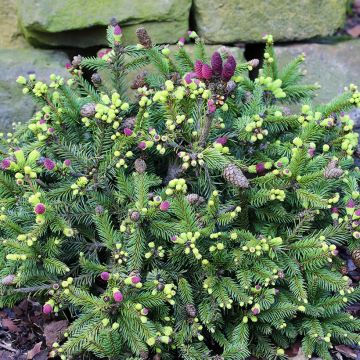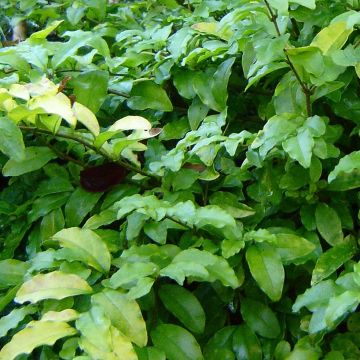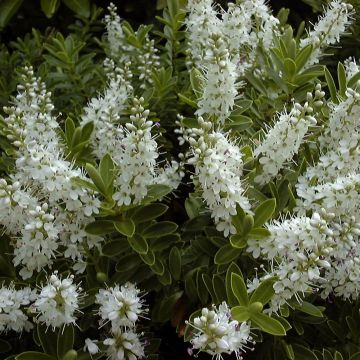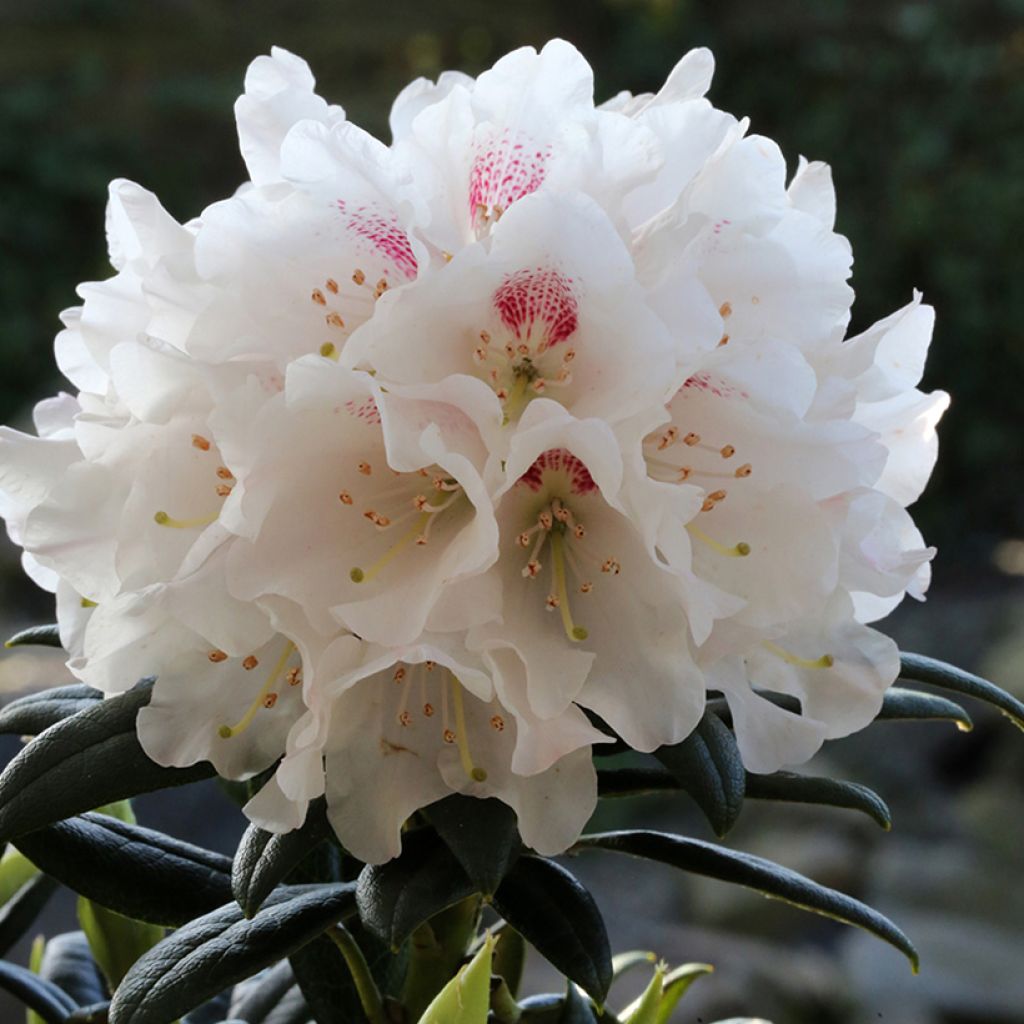

Rhododendron Blewbury
Rhododendron Blewbury
Rhododendron roxieanum Blewbury
Why not try an alternative variety in stock?
View all →This plant carries a 24 months recovery warranty
More information
We guarantee the quality of our plants for a full growing cycle, and will replace at our expense any plant that fails to recover under normal climatic and planting conditions.
From €5.90 for pickup delivery and €6.90 for home delivery
Express home delivery from €8.90.

Does this plant fit my garden?
Set up your Plantfit profile →
Description
Rhododendron Blewbury is an exceptional variety of dwarf rhododendron. Its fantastic white spring flowering covers a lovely elliptical foliage that is slightly convex and pointed with curled edges. The first ornaments in late winter are its bright pink buds. Then, for a long month, from mid-April to mid-May, clusters of 18 to 20 bell-shaped flowers, white with a wine-coloured mark, giving a washed-out pink appearance, almost completely invade the elegant bush. This variety has received an Award of Garden Merit from the Royal Horticultural Society in England. With remarkable elegance and radiance, this little "rhodo" stands out as much as a larger plant in gardens of all sizes.
Rhododendrons are plants of the Ericaceae family, which includes about a hundred genera, many of which are common in our gardens. Heathers, Kalmia, Andromeda, Leucothoe, Oxydendrum, or Gaultheria are valuable in ornamental beds, while Strawberry Trees and especially Blueberries delight us with their fruits. For the most part, these are plants that prefer soils devoid of limestone, with an acidic tendency and humid climates.
Rhododendron Blewbury comes from a rare cross between Rhododendron roxieanum var roxieanum and maculiferum ssp anwheiense. It forms a dense bush with a rounded habit, reaching 80 cm in height and 90 cm in width at maturity. Its evergreen leaves are elliptical in shape, slender, and leathery with curled edges. During April and May, longer flowering than most rhododendrons invades this dwarf shrub, which is literally covered with bright pink floral buds that then open into white flowers about 3.5 cm in size, shaded with light pink, thanks to their wine-coloured markings. The flowers are grouped in terminal clusters composed of 18 to 20 flowers.
Hardy down to -22°C, Rhododendron Blewbury prefers a semi-shade or dappled shade exposure. With slow growth, this acid-loving ericaceous shrub thrives in moist, humus-rich, well-drained soils. It is ideal as a border plant, in a pot, or even as a standalone specimen in a small garden. In a bed, this miniature Rhododendron occupies the foreground, in front of taller acid-loving plants, such as beautiful Kalmias, or Mountain Laurels, with their dark green foliage and pretty small flowers in May-June. It also thrives in the light shade of an Oxydendrum arboreum, whose long clusters of white bells in summer and vibrant autumn foliage provide a spectacle for much of the year. To ensure flowers all year round, complete this picture with an Autumn Camellia like the magnificent Camellia sasanqua Yuletide, whose bright red flowers with yellow stamens enchant your days from November to January.
Report an error about the product description
Plant habit
Flowering
Foliage
Botanical data
Rhododendron
roxieanum
Blewbury
Ericaceae
Cultivar or hybrid
Other Small Rhododendron
Planting and care
Plant Rhododendron Blewbury in a sunny or partially shaded location, protected from cold and drying winds, in moist, humus-rich, light soil with an acidic tendency. Like all plants of the heath family, it does not tolerate limestone soils or heavy soils that become waterlogged in winter. Dig a hole three times larger than the pot. Soak the root ball in non-limestone water and plant the bush at the collar level, in a mixture composed of 1/4 organic matter, leaf compost, gravel or pumice, and loam. Water thoroughly and keep the soil moist in summer. Azaleas and Rhododendrons have a shallow root system. As a result, they are susceptible to long periods of drought. That's why humus-rich soil and abundant watering during dry periods are recommended. In addition, this root system is not very strong, so it is essential to lighten heavy soils with draining materials (gravel, pumice, clay pellets) at planting. Apply a mulch of shredded pine bark at the base of the bush every spring to maintain soil moisture while preserving an acidic pH. Maintenance consists of removing faded flowers in summer and cleaning dead branches. Azaleas and Rhododendrons can sometimes be attacked by weevils that eat the edges of leaves and rootlets, as well as the infamous "rhododendron beetle" which does not often cause severe damage. Yellowing of the leaves (chlorosis) in Rhododendron indicates poor assimilation of iron in the soil and can lead to premature plant death. While limestone is often the cause, poorly drained soil or a deeply planted root ball can also explain the phenomenon.
Planting period
Intended location
Care
This item has not been reviewed yet - be the first to leave a review about it.
Evergreen shrubs
Haven't found what you were looking for?
Hardiness is the lowest winter temperature a plant can endure without suffering serious damage or even dying. However, hardiness is affected by location (a sheltered area, such as a patio), protection (winter cover) and soil type (hardiness is improved by well-drained soil).

Photo Sharing Terms & Conditions
In order to encourage gardeners to interact and share their experiences, Promesse de fleurs offers various media enabling content to be uploaded onto its Site - in particular via the ‘Photo sharing’ module.
The User agrees to refrain from:
- Posting any content that is illegal, prejudicial, insulting, racist, inciteful to hatred, revisionist, contrary to public decency, that infringes on privacy or on the privacy rights of third parties, in particular the publicity rights of persons and goods, intellectual property rights, or the right to privacy.
- Submitting content on behalf of a third party;
- Impersonate the identity of a third party and/or publish any personal information about a third party;
In general, the User undertakes to refrain from any unethical behaviour.
All Content (in particular text, comments, files, images, photos, videos, creative works, etc.), which may be subject to property or intellectual property rights, image or other private rights, shall remain the property of the User, subject to the limited rights granted by the terms of the licence granted by Promesse de fleurs as stated below. Users are at liberty to publish or not to publish such Content on the Site, notably via the ‘Photo Sharing’ facility, and accept that this Content shall be made public and freely accessible, notably on the Internet.
Users further acknowledge, undertake to have ,and guarantee that they hold all necessary rights and permissions to publish such material on the Site, in particular with regard to the legislation in force pertaining to any privacy, property, intellectual property, image, or contractual rights, or rights of any other nature. By publishing such Content on the Site, Users acknowledge accepting full liability as publishers of the Content within the meaning of the law, and grant Promesse de fleurs, free of charge, an inclusive, worldwide licence for the said Content for the entire duration of its publication, including all reproduction, representation, up/downloading, displaying, performing, transmission, and storage rights.
Users also grant permission for their name to be linked to the Content and accept that this link may not always be made available.
By engaging in posting material, Users consent to their Content becoming automatically accessible on the Internet, in particular on other sites and/or blogs and/or web pages of the Promesse de fleurs site, including in particular social pages and the Promesse de fleurs catalogue.
Users may secure the removal of entrusted content free of charge by issuing a simple request via our contact form.
The flowering period indicated on our website applies to countries and regions located in USDA zone 8 (France, the United Kingdom, Ireland, the Netherlands, etc.)
It will vary according to where you live:
- In zones 9 to 10 (Italy, Spain, Greece, etc.), flowering will occur about 2 to 4 weeks earlier.
- In zones 6 to 7 (Germany, Poland, Slovenia, and lower mountainous regions), flowering will be delayed by 2 to 3 weeks.
- In zone 5 (Central Europe, Scandinavia), blooming will be delayed by 3 to 5 weeks.
In temperate climates, pruning of spring-flowering shrubs (forsythia, spireas, etc.) should be done just after flowering.
Pruning of summer-flowering shrubs (Indian Lilac, Perovskia, etc.) can be done in winter or spring.
In cold regions as well as with frost-sensitive plants, avoid pruning too early when severe frosts may still occur.
The planting period indicated on our website applies to countries and regions located in USDA zone 8 (France, United Kingdom, Ireland, Netherlands).
It will vary according to where you live:
- In Mediterranean zones (Marseille, Madrid, Milan, etc.), autumn and winter are the best planting periods.
- In continental zones (Strasbourg, Munich, Vienna, etc.), delay planting by 2 to 3 weeks in spring and bring it forward by 2 to 4 weeks in autumn.
- In mountainous regions (the Alps, Pyrenees, Carpathians, etc.), it is best to plant in late spring (May-June) or late summer (August-September).
The harvesting period indicated on our website applies to countries and regions in USDA zone 8 (France, England, Ireland, the Netherlands).
In colder areas (Scandinavia, Poland, Austria...) fruit and vegetable harvests are likely to be delayed by 3-4 weeks.
In warmer areas (Italy, Spain, Greece, etc.), harvesting will probably take place earlier, depending on weather conditions.
The sowing periods indicated on our website apply to countries and regions within USDA Zone 8 (France, UK, Ireland, Netherlands).
In colder areas (Scandinavia, Poland, Austria...), delay any outdoor sowing by 3-4 weeks, or sow under glass.
In warmer climes (Italy, Spain, Greece, etc.), bring outdoor sowing forward by a few weeks.

































